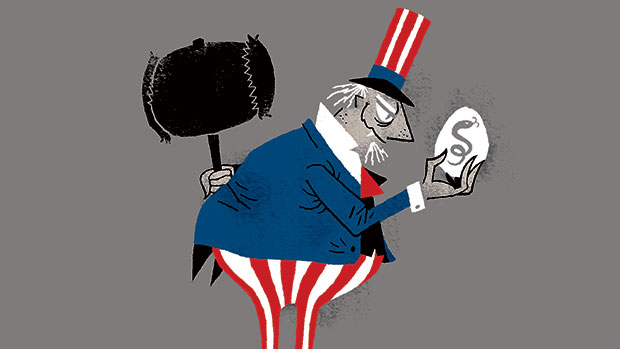
In an old, ironic comedy show, African-American actor and comedian Chris Rock offered what he called an “Educational Video” to his fellow African-Americans, advising them on how to deal with the police. Rock gave tips based on using “common sense” in dealing with the police. His golden advice: “Obey the law.”
Criticising some African-American youths’ attitude might be the type of stand-up comedy Rock is known for since his early days, embodied in an older show he named “Civil war between black people and Niggers”. But Rock’s sarcastic shows and an age-old debate in America could not shake a firm belief among African-Americans that they are targeted by the police and are ready suspects only because of the colour of their skin. This firm belief, which has become a fact of daily life in America, did not come out of thin air; it has its roots in a known history that is alive even today.
The ongoing protests against police violence in some US cities coincided with the debate sparked by the Senate Intelligence Committee report that accused the CIA of lying about its torture of detainees suspected of having links to Al Qaida. This might offer a wider context for the debate about protests, inevitably leading to the abuses of Guantanamo and even the Abu Ghraib prison in Iraq.
Thus, the debate about police violence against African Americans in America opens up a broader context, which is considered by many as the “other side of America”. Certainly, “there is no perfect nation”, as President Barack Obama rightly commented (perhaps for the first time) after the Senate report about the CIA. He added that “one of the strengths that makes America exceptional is our willingness to openly confront our past, face our imperfections, make changes and do better.” But this broader context warrants the urgent question of whether this “other side of America” works on erosion of liberal traditions in the country, albeit gradually.
There have been similar chapters in American history: The persecution of Italian immigrants in the 1920s, which reached its climax with the execution of Nicola Sacco and Bartolomeo Vanzetti; the wave of hatred against the Jews in the 1950s down to McCarthyism, one of the ugliest chapters of modern American history which lasted from the early 1950s to mid-1970s.
But the collective memory of African-Americans is more burdened than that of others, ranging from the era of slavery and later racial segregation laws through the years of major protests for civil rights in the 1960s and 1970s. This is history now, as the other side showcases the highly symbolic presence of an African-American in the White House and, similarly, former policy makers such as the former national security advisor and secretary of State Condoleezza Rice and former Chairman of the Joint Chiefs of Staff and secretary of State Colin Powell and many others in all fields. Yet, the oppression of African-Americans seems to be an undeniable fact of daily life in America.
What is the common denominator in all these chapters? What is the most eloquent definition or just a “feel” of persecution? The answer is humiliation.
If the debate between the protesters and police narrative of shooting young black people remains a constant and controversial one for years ahead, the chapter of Abu Ghraib will also remain an indisputable aspect of “the other side of America”.
No matter how rhetorical the descriptions are of what happened in Abu Ghraib and no matter how disgusting the details, it will always be seen as “a deliberate humiliation”.
In his investigative report about Abu Ghraib published in the The New Yorker (May 10, 2004), the veteran American journalist Seymour Hersh quoted the attorney of the six of the accused soldiers as saying: “Do you really believe the Army relieved a general officer because of six soldiers? Not a chance.”
But Abu Ghraib was not an isolated incident or reckless behaviour by six US soldiers; it’s a part and parcel of the American occupation of Iraq. Only in this context will we see clearly that what happened in Abu Ghraib embodies the biggest failure of the occupation: Americans didn’t win Iraqis’ hearts but made more enemies. The chapter of Abu Ghraib proved that Americans learned an art that is almost exclusive to this region and in particular to the regime they overthrew: The art of making enemies.
Unfortunately, history does not provide any example that suggests that change either in America or anywhere else will occur voluntarily, smoothly and, more importantly, without the cost of human lives. Racial discrimination against African-Americans resulted in one of the largest protests movements for civil rights led by the Dr. Martin Luther King Jr. It was purely a civilian movement, but stubbornness continued and when Dr King was assassinated in 1964, part of the protests became more radical with the emergence of organisations such as the “Black Panthers” and “Black Liberation Army”. This plunged America into extremism with a wave of violence sweeping across the country almost till the end of the 1970s.
It wasn’t different in Iraq. Despite a new political life and frequent elections, American policies of making enemies left a “serpent’s egg” that hatched under their occupation, which can, in a very courteous, academic definition, be called “extremism”. It’s worst manifestation is Daesh (Islamic State of Iraq and the Levant).
Occupation may not be enough to provide a motive for anyone to bear arms, except for those who will be motivated by patriotic fervour and they are a few, in any case. But humiliation would do that spontaneously and without hesitation. That’s the way it went with the revolutions of the Sunni tribes, in which the policies of the successive Iraqi governments provided additional justification. The successive regimes showed that they were well versed in the art of making enemies.
Mohammad Fadhel is a Bahraini writer and media consultant at “b’huth” (Dubai).









